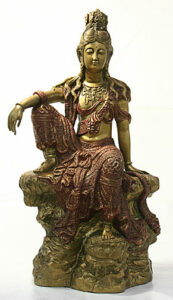Medical Research
Bee Venom, Acupuncture and Parkinson's Disease
Kristen Sparrow • October 20, 2015


Goddess of Compassion
“She who hears the cries of the world”
I’ve been interested in bee venom for a few years since it combines a few things that might be significant in stimulation the healing response in the context of needling/acupuncture. One is that it distends the tissues, but two is that it causes an immune response. My hunch is that these responses may amplify the physiological response.bee venom for parkinsons
A Prospective Open-Label Study of Combined Treatment
for Idiopathic Parkinson’s Disease Using Acupuncture
and Bee Venom Acupuncture as an Adjunctive Treatment
Kyeong-Hee Doo, KMD, MS,
1,2
Ji-Hyun Lee, KMD, MS,
1,2
Seung-Yeon Cho, KMD, PhD,
1,2
Woo-Sang Jung, KMD, PhD,
1
Sang-Kwan Moon, KMD, PhD,
1
Jung-Mi Park, KMD, PhD,
1,2
Chang-Nam Ko, KMD, PhD,
1,2
Ho Kim, PhD,
3
Hi-Joon Park, KMD, PhD,
4
and Seong-Uk Park, KMD, PhD
1,2
Abstract
Objectives:
The purpose of this study was to examine the effectiveness and safety of combined treatment using
acupuncture and bee venom acupuncture (BVA) as an adjunctive treatment for idiopathic Parkinson’s disease (PD).
Methods:
Eleven patients (7 men and 4 women) with idiopathic PD who had been receiving a stable dose of
anti-parkinsonian medication for at least 4 weeks. Participants received conventional treatment for 12 weeks.
Subsequently, they received additional treatment with acupuncture and BVA twice weekly for 12 weeks while
still maintaining conventional treatment. All participants were assessed at baseline, 12 weeks, and 24 weeks by
using the Unified Parkinson’s Disease Rating Scale (UPDRS), the Parkinson’s Disease Quality of Life Ques-
tionnaire (PDQL), the speed and number of steps required to walk 20 m, and the Beck Depression Inventory
(BDI). Maximum excursion and directional control, measured by computerized dynamic posturography (Bal-
ance Master
System, NeuroCom, San Carlos, CA), were used to assess postural stability.
Results:
Patients who
underwent 12 weeks of twice-weekly combined treatment with acupuncture and BVA showed
significant improvements in gait speed, PDQL score, activities of daily living (UPDRS part II), motor symptoms
(UPDRS part III), and combined UPDRS part II
+
III scores compared with assessments after conventional treatment.
Conclusions:
Combined treatment with acupuncture and BVA showed promising results as a safe adjunctive therapy for patients with PD.

